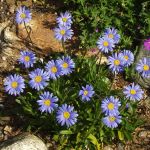| Common Name: |
Tatarian Aster |
| Botanical Name: |
Aster tataricus |
| Genus: |
Aster |
| Family: |
Asteraceae |
| Native Location: |
Siberia, Mongolia, Korea, China and Japan |
| Cultivation: |
Moist soil in sun or partial shade. May suffer from mildew in dry conditions. |
| Propagation: |
By seed sown in autumn or spring; by division in spring. |
| Harvest: |
Roots are lifted in autumn and used raw, or dried for decoctions. |
| Height: |
1.5-2m (5-6ft) |
| Width: |
1-1.2m (3-4ft) |
| Hardiness: |
Z3-8 |
| Parts Used: |
Roots (zi wan) |
| Properties: |
A stimulant, expectorant herb that helps clear infection from the bronchial system. |
| Medicinal Uses: |
Internally for chronic bronchitis and tuberculosis. Often taken raw with honey to increase the expectorant effect. |
| Bibliography: |
Encyclopedia of Herbs by Deni Brown Copyright © 1995, 2001 Dorling Kindersley Limited Pg 136 |

